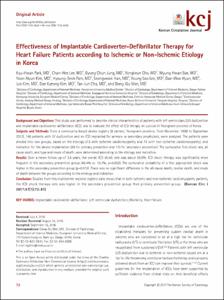KUMEL Repository
1. Journal Papers (연구논문)
1. School of Medicine (의과대학)
Dept. of Internal Medicine (내과학)
Effectiveness of Implantable Cardioverter-Defibrillator Therapy for Heart Failure Patients according to Ischemic or Non-Ischemic Etiology in Korea
- Keimyung Author(s)
- Kim, Yoon Nyun; Park, Hyoung Seob
- Department
- Dept. of Internal Medicine (내과학)
- Journal Title
- Korean Circulation Journal
- Issued Date
- 2017
- Volume
- 47
- Issue
- 1
- Keyword
- Implantable cardioverter-defibrillator; Left ventricular dysfunction; Mortality; Heart failure
- Abstract
- Background and Objectives: This study was performed to describe clinical characteristics of patients with left ventriculars (LV) dysfunction
and implantable cardioverter-defibrillator (ICD), and to evaluate the effect of ICD therapy on survival in Yeongnam province of Korea.
Subjects and Methods: From a community-based device registry (9 centers, Yeongnam province, from November 1999 to September
2012), 146 patients with LV dysfunction and an ICD implanted for primary or secondary prophylaxis, were analyzed. The patients were
divided into two groups, based on the etiology (73 with ischemic cardiomyopathy and 73 with non-ischemic cardiomyopathy), and
indication for the device implantation (36 for primary prevention and 110 for secondary prevention). The cumulative first shock rate, all
cause death, and type and mode of death, were determined according to the etiology and indication.
Results: Over a mean follow-up of 3.5 years, the overall ICD shock rate was about 39.0%. ICD shock therapy was significantly more
frequent in the secondary prevention group (46.4% vs. 16.7%, p=0.002). The cumulative probability of a first appropriate shock was
higher in the secondary prevention group (p=0.015). There was no significant difference in the all-cause death, cardiac death, and mode
of death between the groups according to the etiology and indication.
Conclusion: Studies from this multicenter regional registry data shows that in both ischemic and non-ischemic cardiomyopathy patients,
the ICD shock therapy rate was higher in the secondary prevention group than primary prevention group.
- Publisher
- School of Medicine
- Citation
- Byung Chun Jung et al. (2017). Effectiveness of Implantable Cardioverter-Defibrillator Therapy for Heart Failure Patients according to Ischemic or Non-Ischemic Etiology in Korea. Korean Circulation Journal, 47(1), 72–81. doi: 10.4070/kcj.2016.0242
- Type
- Article
- ISSN
- 1738-5520
- Appears in Collections:
- 1. School of Medicine (의과대학) > Dept. of Internal Medicine (내과학)
- 파일 목록
-
-
Download
 oak-2017-0272.pdf
기타 데이터 / 327.04 kB / Adobe PDF
oak-2017-0272.pdf
기타 데이터 / 327.04 kB / Adobe PDF
-
Items in Repository are protected by copyright, with all rights reserved, unless otherwise indicated.